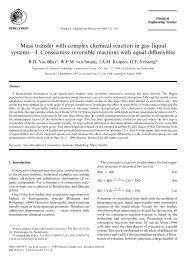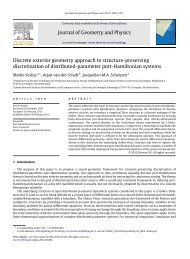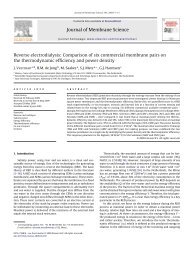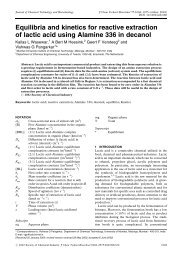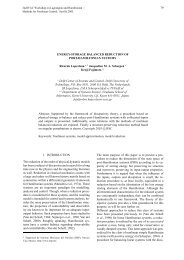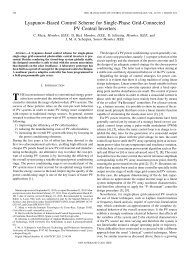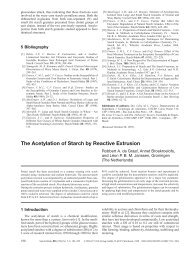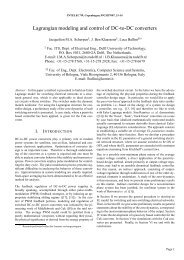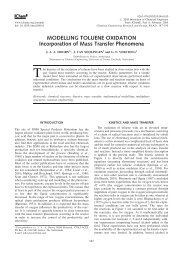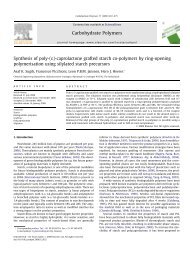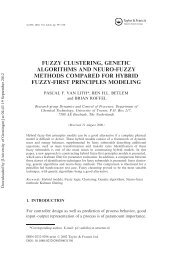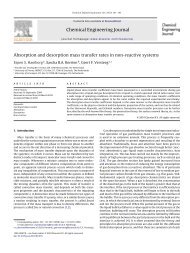Reverse electrodialysis: evaluation of suitable electrode systems - ITM
Reverse electrodialysis: evaluation of suitable electrode systems - ITM
Reverse electrodialysis: evaluation of suitable electrode systems - ITM
You also want an ePaper? Increase the reach of your titles
YUMPU automatically turns print PDFs into web optimized ePapers that Google loves.
1472 J Appl Electrochem (2010) 40:1461–1474Brogioli succeeded in the reversal <strong>of</strong> the capacitivedeionization (CD) technique [55]. The capacitor is formedby two activated carbon <strong>electrode</strong>s, immersed in the feedsolution, alternately salt and fresh water. When filled withsalt water, it is charged, and with fresh water it is discharged.Charging and discharging are promoted by thediffusion <strong>of</strong> ions and consequently there is a net energygain.e Systems with an <strong>electrode</strong> rinse solution containingcarbon particles and/or ion exchange resin particlesThese <strong>systems</strong> are described by Kedem et al. for use innormal <strong>electrodialysis</strong> and patented [56, 57]. The <strong>electrode</strong>rinse solution contains about 1% active carbon and 1%cation exchange resin in a NaCl solution <strong>of</strong> about 2%. Theauthors suggest that this system is based on the reversiblesystemH þ þ e 1 = 2 H 2The H 2 gas, as evolved at the cathode is adsorbed by thecarbon and transported to the anode where the reversereaction proceeds. The involved H ? is transported by theion exchange resin:RH þ Na þ RNa þ H þwhere RH is the resin in the acid form and RNa the resin inthe salt form.The net reaction at the cathode and at the anode istherefore:RH þ Na þ þ e RNa þ 1 = 2 H 25 ConclusionsIn this work, self-developed <strong>electrode</strong> <strong>systems</strong> and <strong>electrode</strong><strong>systems</strong> described in literature are compared onsafety, health, environment, technical feasibility and economics.A robust system <strong>of</strong> judging the different <strong>systems</strong> ispresented. Applying this system to the described and used<strong>systems</strong>, a ranking was made <strong>of</strong> the different <strong>electrode</strong><strong>systems</strong>. It is shown that the applicability <strong>of</strong> an <strong>electrode</strong>system is related to the generating system. Three types <strong>of</strong>generating <strong>systems</strong> can be distinguished: <strong>systems</strong> with (i)obligatory, (ii) facultative and (iii) forbidden interchange<strong>of</strong> the feed water inlets. The highest rankings for all thethree generating <strong>systems</strong> are found for the Fe 2? /Fe 3?couple in a NaCl–HCl supporting electrolyte with bidirectionalRu/Ir covered titanium <strong>electrode</strong>s.This system is not ideal and may be improved forapplication in commercial operating, large scale RED.There are five interesting topics: (i) improved stable metal<strong>electrode</strong>s (with longer lifetime, <strong>suitable</strong> for currentreversal and high overpotential for gas evolvement), (ii) anew homogeneous redox couple (e.g. an iron complex),(iii) a system with capacitive <strong>electrode</strong>s, (iv) a system withan electrolyte, containing carbon particles and/or ionexchange resin particles, and (v) the Fe 2? /Fe 3? couple incombination with graphite <strong>electrode</strong>s. The last improvementseems to be the most realistic alternative; however,duration test should be performed under real RED conditionsto prove that it has sufficient mechanical and electrochemicalstability.Acknowledgement This work was performed in the TTIW-cooperationframework <strong>of</strong> Wetsus, centre <strong>of</strong> excellence for sustainablewater technology (www.wetsus.nl). Wetsus is funded by the DutchMinistry <strong>of</strong> Economic Affairs, the European Union Regional DevelopmentFund, the province <strong>of</strong> Fryslân, the city <strong>of</strong> Leeuwarden and theEZ/Kompas program <strong>of</strong> the ‘‘Samenwerkingsverband Noord-Nederland’’.The first author would like to thank the Noordelijke HogeschoolLeeuwarden who facilitated this research by detaching him toWetsus and the participants <strong>of</strong> the theme ‘‘Energy’’ for their fruitfuldiscussions and their financial support.Open Access This article is distributed under the terms <strong>of</strong> theCreative Commons Attribution Noncommercial License which permitsany noncommercial use, distribution, and reproduction in anymedium, provided the original author(s) and source are credited.AppendixApplied criteria.The used marks are: good = 5; reasonable = 4;acceptable = 3; poor = 2; bad = 1 and unacceptable = 0.In some cases minus signs are used. These mean that theirvalue should be subtracted from the maximal score <strong>of</strong> 5.A Technical feasibilityA 1 Reversal <strong>of</strong> the electrical currentscore: Already given in Table 2A 2 Stability <strong>of</strong> the anolyte/catholyteScoreNo instable ions 5[Fe(CN) 6 ] 4- , [Fe(CN) 6 ] 3- 4A 3 Gas formation at the <strong>electrode</strong>sScoreNo gas 5O 2 formation -1Cl 2 formation -2H 2 formation -1A 4 Participating <strong>electrode</strong>sScoreNo participating <strong>electrode</strong>s 5Participating without problems (Cu) 4123



